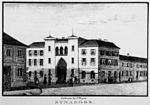Wildparkstadion

Wildparkstadion, currently known as BBBank Wildpark for sponsorship reasons, is a football stadium located in Karlsruhe, Germany. It is the home of the football club Karlsruher SC. It is located northeast of the Karlsruhe Palace (Schloss) and is part of the former deer park (Wildpark) of the Grand Dukes of Baden in the Hardtwald, hence the name. There have been football pitches at the location since 1922, and the stadium was built in 1955, with several major renovations since. A decision to rebuild the stadium was taken in 2006. The City of Karlsruhe and Karlsruher SC became engulfed in disputes about finances and finally abandoned the project in 2014. Two years later, the city again decided to renew the stadium, using the existing site and financed mostly by the city. In November 2018, demolition of parts of the old stadium and the concurrent construction of a new 34,000-seat arena began. Works are being carried out in stages so that matches can be played on the existing pitch in front of at least 15,000 spectators. The new Wildparkstadion is expected to be completed in the first half of 2022 at a projected cost of €123 Million. In 2021, it was announced that BBBank had acquired the naming rights to the stadium for five years.
Excerpt from the Wikipedia article Wildparkstadion (License: CC BY-SA 3.0, Authors, Images).Wildparkstadion
Adenauerring, Karlsruhe Innenstadt-Ost
Geographical coordinates (GPS) Address Website External links Nearby Places Show on map
Geographical coordinates (GPS)
| Latitude | Longitude |
|---|---|
| N 49.02 ° | E 8.4130555555556 ° |
Address
BBBank Wildpark
Adenauerring
76131 Karlsruhe, Innenstadt-Ost
Baden-Württemberg, Germany
Open on Google Maps










